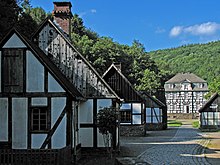Wilhelm Claas
Eugen Karl Gustav Wilhelm Claas (* 1885 in Hagen ; † 1966 ) was a German university professor, local researcher and photographer , known for his series of technical cultural monuments . He is considered the spiritual father of the Westphalian Open-Air Museum of Technical Cultural Monuments Hagen , which later became the Westphalian Open-Air Museum of Hagen of the Westphalia-Lippe Regional Association.
Life
Claas grew up in Hagen and studied architecture in Hanover from 1905 to 1911 . After the state examination for building construction in 1915, he was trained as a building officer ; Claas carried out corresponding activities in the First World War . From 1919 he worked as a lecturer at the State Building Trade School in Essen. In his work areas of urban architecture, urban topography and commercial architecture, Claas devoted himself to his urban environment and its changes.
Claas was a representative of the Heimat movement that emerged in the last third of the 19th century. With an architecture-critical approach, Claas registered the rapid changes in city and landscape images as a result of industrial transformation. He spent a total of forty years of his life capturing the living and working space of his homeland in writing and especially in photography. From the 1920s until his death, he devoted his free time and parts of his professional working time to this task when he taught at the technical college for civil engineering in Essen. Claas was influenced by Friedrich Ratzel's (1814–1904) cultural research , which tried to describe so-called cultural areas based on the spatial distribution of cultural phenomena .
Claas transferred the cultural space research program to its second major area of work, the study of technical cultural monuments ; "His book, Technical Cultural Monuments of the Former County of Mark , published in 1939, served not least to refute doubts about the 'down-to-earth character' of the workshop buildings that he was trying to preserve". When dealing with this architecture, he was not limited to Hagen and its surroundings, but explored technical monuments in the Märkisches Kreis and Bergisches Land , beyond all of Westphalia , and to a lesser extent on his vacation trips to Bavaria, Austria, Italy, the Eifel and the Hunsrück .
In contrast to Werner Lindner , managing director of the Federation of German Homeland Security since 1914, who was more concerned with the “reconstruction of the work enforcement” and wanted to use film as a medium, Claas emphasized the aesthetic needs of homeland security. Therefore, his architecturally determined interest in the cultural monuments was strongly documentary. In his recordings he tried to capture what was endangered; Claas used the camera purely for instrumental purposes and largely dispensed with dramatic effects in his black and white photos. His style is characterized by the deliberate renunciation of everything picturesque and the restriction to the essential motif. Wilhelm Claas' photographic estate consists of slides , glass plate negatives and negative films that were hidden in several places during the Second World War and brought together again in the Westphalian Open-Air Museum in Hagen in the mid-1960s.
Since it was only possible to a limited extent in the 1930s to make the preservation of technical cultural monuments on site part of the common property, Claas demanded the creation of an open-air museum of technical cultural monuments , which should be built as a central facility in Hagen. Wilhelm Claas made the proposal for such a museum in Hagen as early as 1931, referring to Oskar von Miller , undertook plans in 1936/37 on behalf of the city and published them in 1939, which, however, were no longer pursued due to the turning point of the Second World War. The actual implementation of Claas' ideas did not take place until 1960 with the establishment of a sponsoring association and the start of the museum, which Claas is considered to be the spiritual father of.
Publications (selection)
- The technical cultural monuments in the area of the former County of Mark. Edited on behalf of the city of Hagen. Hagen, Westfälische Verlagsanstalt Thiebes & Co., 1939.
- The home cemetery - a review and outlook , in: Die Heimat 10 (1928), pp. 326-330
- Technical cultural monuments in the area of the former County of Mark. (In: Hagen contributions to history and regional studies. Ed .: Stadt Hagen, issue 013). Hagen, Linnepe Verlagsgesellschaft, 1958.
literature
- Uwe Beckmann: Wilhelm Claas photographs - architecture and technical cultural monuments. Craft research materials. Hagen, vd Linnepe Verlag, 1993
Web links
Individual evidence
- ↑ a b Wilhelm Claas: Photographs , p. 11.
- ^ Wilhelm Claas: Photographs , p. 13 ff.
- ↑ a b c Uwe Beckmann: Claas, Photographs, p. 21, ff.
- ↑ Uwe Beckmann: Claas, Photographs, p. 24, ff.
- ↑ Uwe Beckmann: Claas, Photographs, p. 34
- ↑ Frieder Schmidt: Technical cultural monuments - emergence and change of a concept. In: Technology between acceptance and resistance , ed. by Gerhard A. Stadler p. 70
- ↑ Susanne Hauser: Metamorphoses of waste: Concepts for old industrial areas , 2001
- ^ Gerhard A. Stadler: The industrial heritage of Lower Austria , 2006, page 23.
- ↑ Uwe Beckmann: "Technical cultural monuments as objects of technical culture for German engineers and homeland guards". In: Burkhard Dietz: Technical Intelligence and "Culture Factor Technology". Waxmann Verlag, 1996, ISBN 978-3-893-25447-7 , p. 178 ( limited preview in Google book search)
| personal data | |
|---|---|
| SURNAME | Claas, Wilhelm |
| ALTERNATIVE NAMES | Claas, Eugen Karl Gustav Wilhelm |
| BRIEF DESCRIPTION | German homeland researcher |
| DATE OF BIRTH | 1885 |
| PLACE OF BIRTH | Hagen |
| DATE OF DEATH | 1966 |
